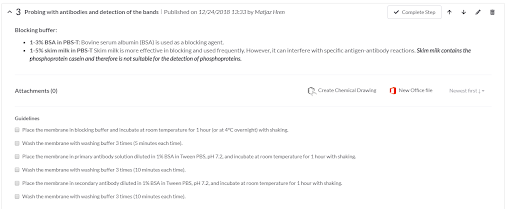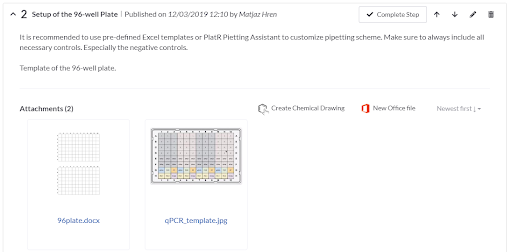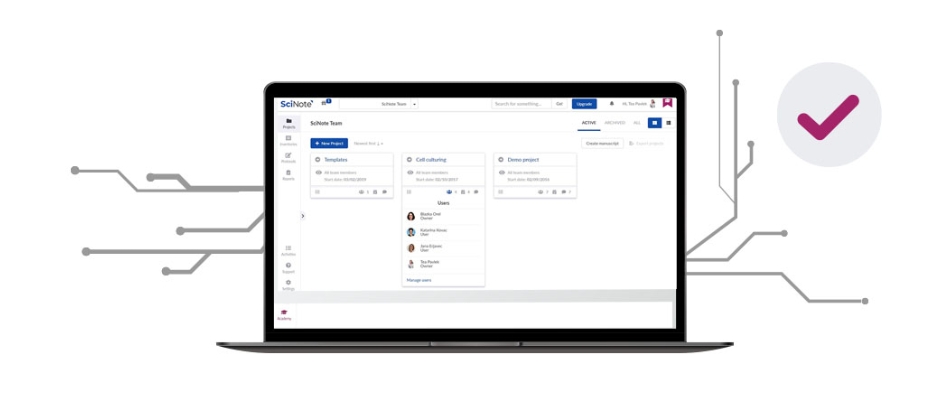How To Write A Lab Protocol
![]() 5 min read
5 min read
In the scientific context, protocols are typically the step-by-step instruction on how you can complete an experiment. Protocols can eventually get summarized in the Materials and Methods section of a research paper, graduation or PhD thesis or SOPs that you use in research or diagnostic lab. They play an important role in scientific discoveries to ensure experimental steps are consistent, and it is possible to reproduce an experiment.
In a broader sense, protocols can be much more general, including cooking recipes, operational procedures, user manuals for lab or office equipment, safety or any other checklists and guidelines.
In SciNote, protocols are interactive and executable; this ensures traceability of your experimental data. Each SciNote protocol consists of two main elements: Metadata (protocol title, keywords, authors, and protocol description), and Protocol steps. You can use the following guide to structure your protocol.
Key components of your protocol
Protocol metadata: Title, keywords, authors, and description
Metadata are often overlooked when a protocol is created. However, metadata can be important as they provide context to the protocol – what conditions the experiment should be conducted under, what preparations are needed, who input the protocol, and other useful information.
The Title and Keywords are useful as they describe the protocol and will help you find it faster in the protocol repository; make sure to use a descriptive title and tag the protocol with relevant keywords. If you have any questions about the protocol, you can consult the original Author who entered the protocol.
Protocol description is a good place to summarize the protocol or describe things you need to do before executing the protocol in the lab, such as reminders to switch on instruments, thaw frozen samples or reagents, locate all the consumables such as pipette tips, 96 well plates, test tubes, and ice.
Protocol Steps
The main part of the protocol are Protocol steps. They contain instructions for execution. Protocol steps in SciNote have different elements available that help you design the steps:
- Title: summary of the step. In some case, the step is really specific (e.g. Incubate at 56°C for 15 min), then this is all the information you will need in this step. In other cases, you might want to include additional information to supplement the step title.

- Description: When a step is too complex to fit into a one-line-protocol-title, add the supporting information, additional explanations, and other notes into Step description. You can insert links and images, and format your text here.

- Checklists: The main advantage of SciNote checklists (vs. over bullet points that you can insert into Step description) is that checking and unchecking of individually listed items in a SciNote checklist is recorded as an individual activity in the activity log. We recommend using SciNote checklists where such a level of traceability is needed (e.g., to confirm you added all the components into a reagent mix, or when the step is complex but it is necessary to keep it as a step instead of breaking it up into more steps.)

- Tables: Tables can be used for performing simple calculations, listing reagent mixes, or setting up 96-well plate maps.
- Attachments (Files): You can attach files such as more elaborated plate maps (e.g. 96-well, 384-well plate maps drawn in Excel), lists of complex reagent mixes, Excel-based templates for result calculation, pictures of instruments, or event instructions for operating instruments.

- Comments: When you have remarks about protocol execution in the lab, or you would like to propose a protocol modification, you can write it down in as a comment. Remember, you can cross-reference other team members here as well. For example, you can tag your colleague or your supervisor if you need feedback or something requires immediate attention.
Examples & Tips
Generally, it is better to have many simpler steps than fewer complex steps.
It may seem more work during protocol execution (more clicking or more checking). However, if someone interrupts you in the lab, the more granulated steps you have in your protocol, the less likely you will forget which part of the protocol you already completed, and which part you did not.
- For example, you can split up more complex steps like “Add 600 μL of buffer A to the column. Close the lid, and centrifuge for 2 min at ≥8000 x g.” into two steps:

- Write out repeated steps: instead of “repeat steps 10-11” or “wash pellets 3 times with buffer A,” spell out the individual steps:

or

Be concise when describing steps. Less is more – too much text makes it hard to follow.
Have the gist of the step in the title, and move your notes to the Description of the step.

Use smart annotations to refer to or cross-reference other Projects, Experiments, Tasks, instruments, reagents, storage when needed. This will help you cross-reference within your data, and trace back to what reagents or instruments you used, where things are stored, or what projects or experiments the protocol is for.

You can find additional examples in two SciNote projects: Templates and [NEW] Demo project. These projects contain many examples of protocols on Tasks. These examples can help you design individual steps in your protocols.
If you have other questions, make sure to check out our knowledge base and video tutorials, visit the resources in SciNote Academy, or join the LinkedIn community to learn from other SciNote users.


